Organisations and Business Environment: A Case Study Analysis
VerifiedAdded on 2024/05/29
|18
|4110
|56
Case Study
AI Summary
This assignment provides a comprehensive analysis of the business environment, focusing on different types of organisations, their structures, and functions. It includes an essay discussing profitable, non-profitable, and non-governmental organisations, along with their size and scope. The assignment also presents a case study of the UK supermarket sector, utilizing PESTLE and SWOT analysis to evaluate the macro environment's impact on Marks and Spencer. The study identifies internal strengths and weaknesses, correlating them with external macro factors, and concludes by emphasizing the importance of aligning organisational structure and functions with the mission and objectives for optimal operational clarity and efficiency. Desklib offers a range of solved assignments and past papers for students.
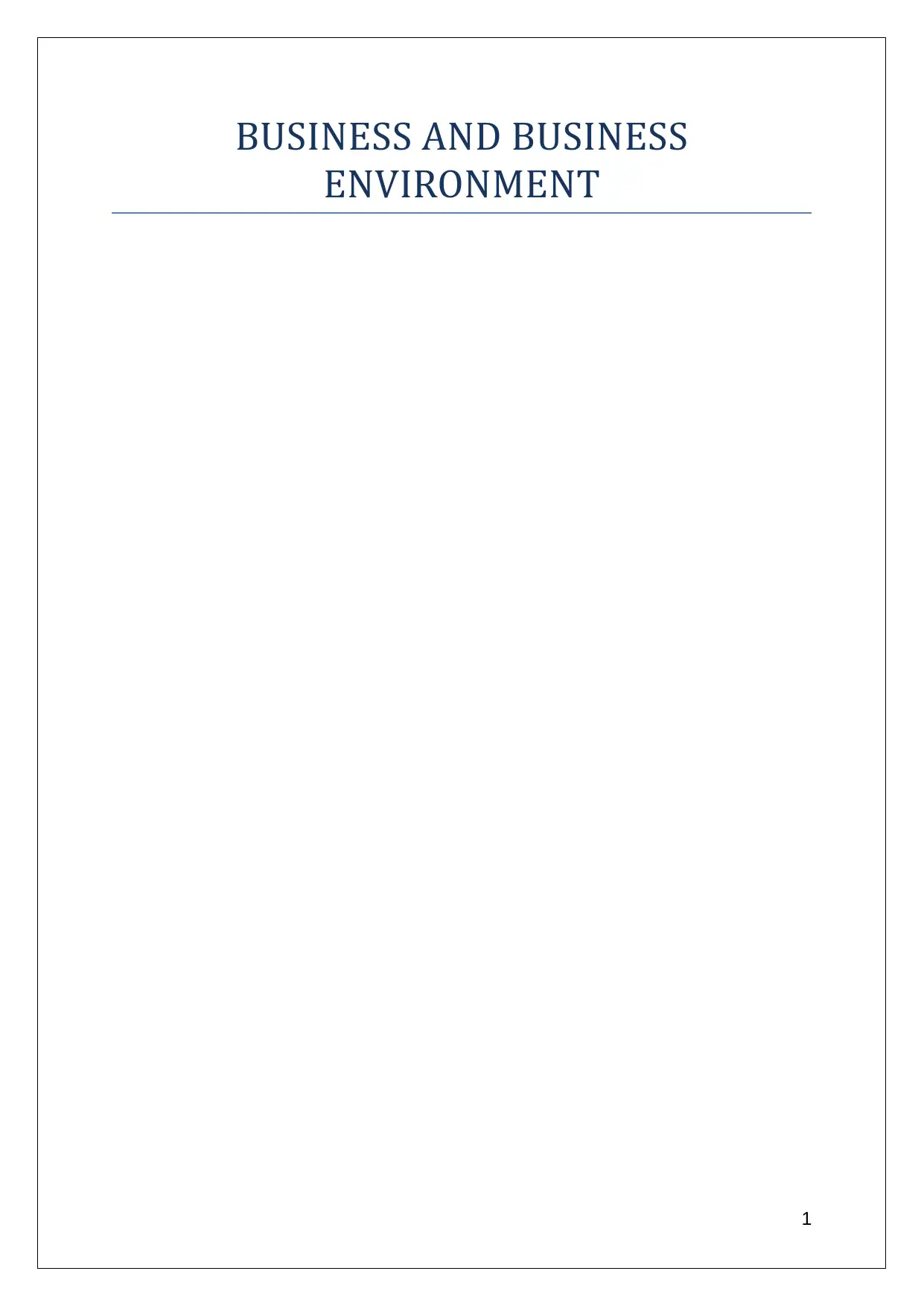
BUSINESS AND BUSINESS
ENVIRONMENT
1
ENVIRONMENT
1
Paraphrase This Document
Need a fresh take? Get an instant paraphrase of this document with our AI Paraphraser
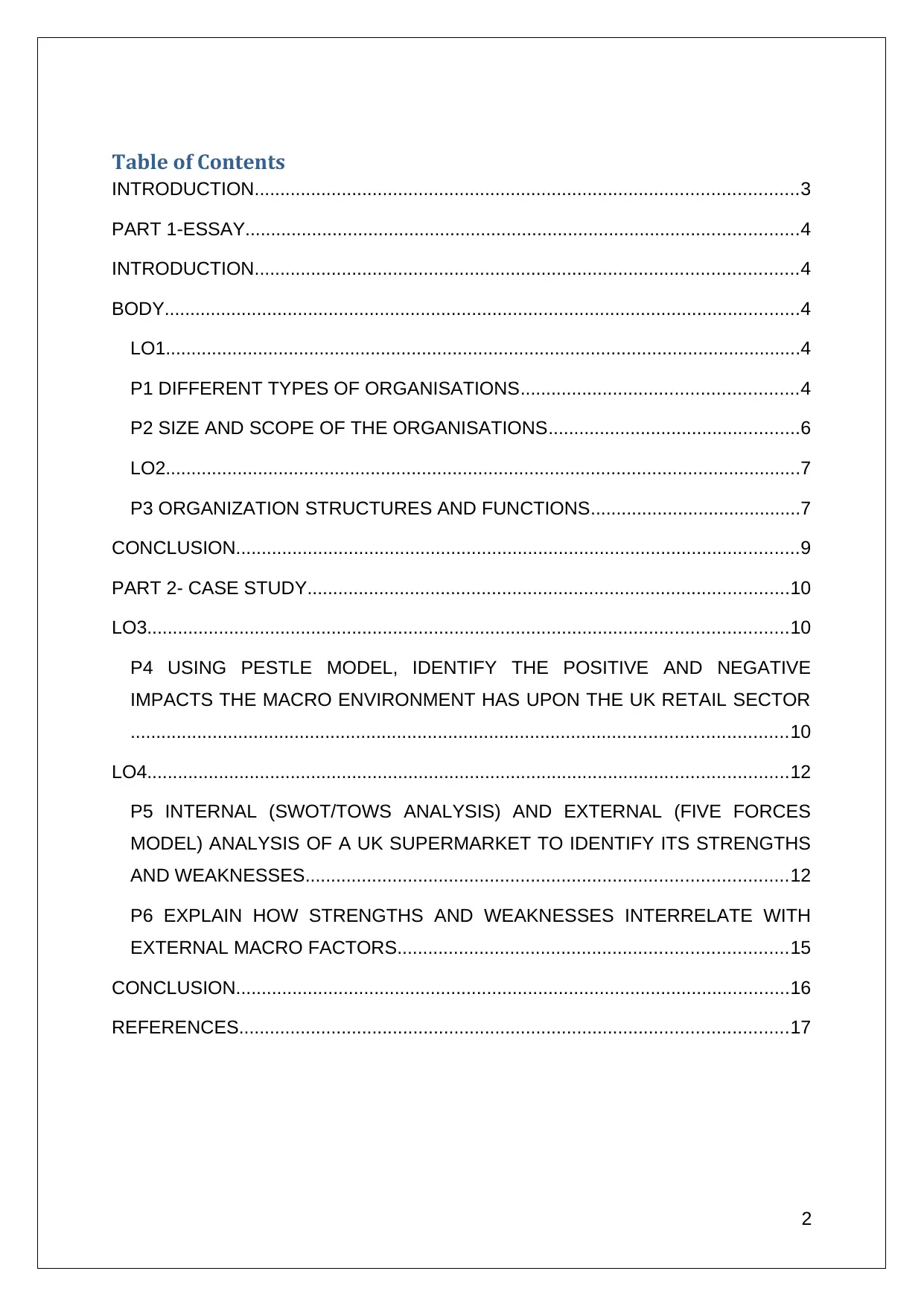
Table of Contents
INTRODUCTION..........................................................................................................3
PART 1-ESSAY............................................................................................................4
INTRODUCTION..........................................................................................................4
BODY............................................................................................................................4
LO1............................................................................................................................4
P1 DIFFERENT TYPES OF ORGANISATIONS......................................................4
P2 SIZE AND SCOPE OF THE ORGANISATIONS.................................................6
LO2............................................................................................................................7
P3 ORGANIZATION STRUCTURES AND FUNCTIONS.........................................7
CONCLUSION..............................................................................................................9
PART 2- CASE STUDY..............................................................................................10
LO3.............................................................................................................................10
P4 USING PESTLE MODEL, IDENTIFY THE POSITIVE AND NEGATIVE
IMPACTS THE MACRO ENVIRONMENT HAS UPON THE UK RETAIL SECTOR
................................................................................................................................10
LO4.............................................................................................................................12
P5 INTERNAL (SWOT/TOWS ANALYSIS) AND EXTERNAL (FIVE FORCES
MODEL) ANALYSIS OF A UK SUPERMARKET TO IDENTIFY ITS STRENGTHS
AND WEAKNESSES..............................................................................................12
P6 EXPLAIN HOW STRENGTHS AND WEAKNESSES INTERRELATE WITH
EXTERNAL MACRO FACTORS............................................................................15
CONCLUSION............................................................................................................16
REFERENCES...........................................................................................................17
2
INTRODUCTION..........................................................................................................3
PART 1-ESSAY............................................................................................................4
INTRODUCTION..........................................................................................................4
BODY............................................................................................................................4
LO1............................................................................................................................4
P1 DIFFERENT TYPES OF ORGANISATIONS......................................................4
P2 SIZE AND SCOPE OF THE ORGANISATIONS.................................................6
LO2............................................................................................................................7
P3 ORGANIZATION STRUCTURES AND FUNCTIONS.........................................7
CONCLUSION..............................................................................................................9
PART 2- CASE STUDY..............................................................................................10
LO3.............................................................................................................................10
P4 USING PESTLE MODEL, IDENTIFY THE POSITIVE AND NEGATIVE
IMPACTS THE MACRO ENVIRONMENT HAS UPON THE UK RETAIL SECTOR
................................................................................................................................10
LO4.............................................................................................................................12
P5 INTERNAL (SWOT/TOWS ANALYSIS) AND EXTERNAL (FIVE FORCES
MODEL) ANALYSIS OF A UK SUPERMARKET TO IDENTIFY ITS STRENGTHS
AND WEAKNESSES..............................................................................................12
P6 EXPLAIN HOW STRENGTHS AND WEAKNESSES INTERRELATE WITH
EXTERNAL MACRO FACTORS............................................................................15
CONCLUSION............................................................................................................16
REFERENCES...........................................................................................................17
2
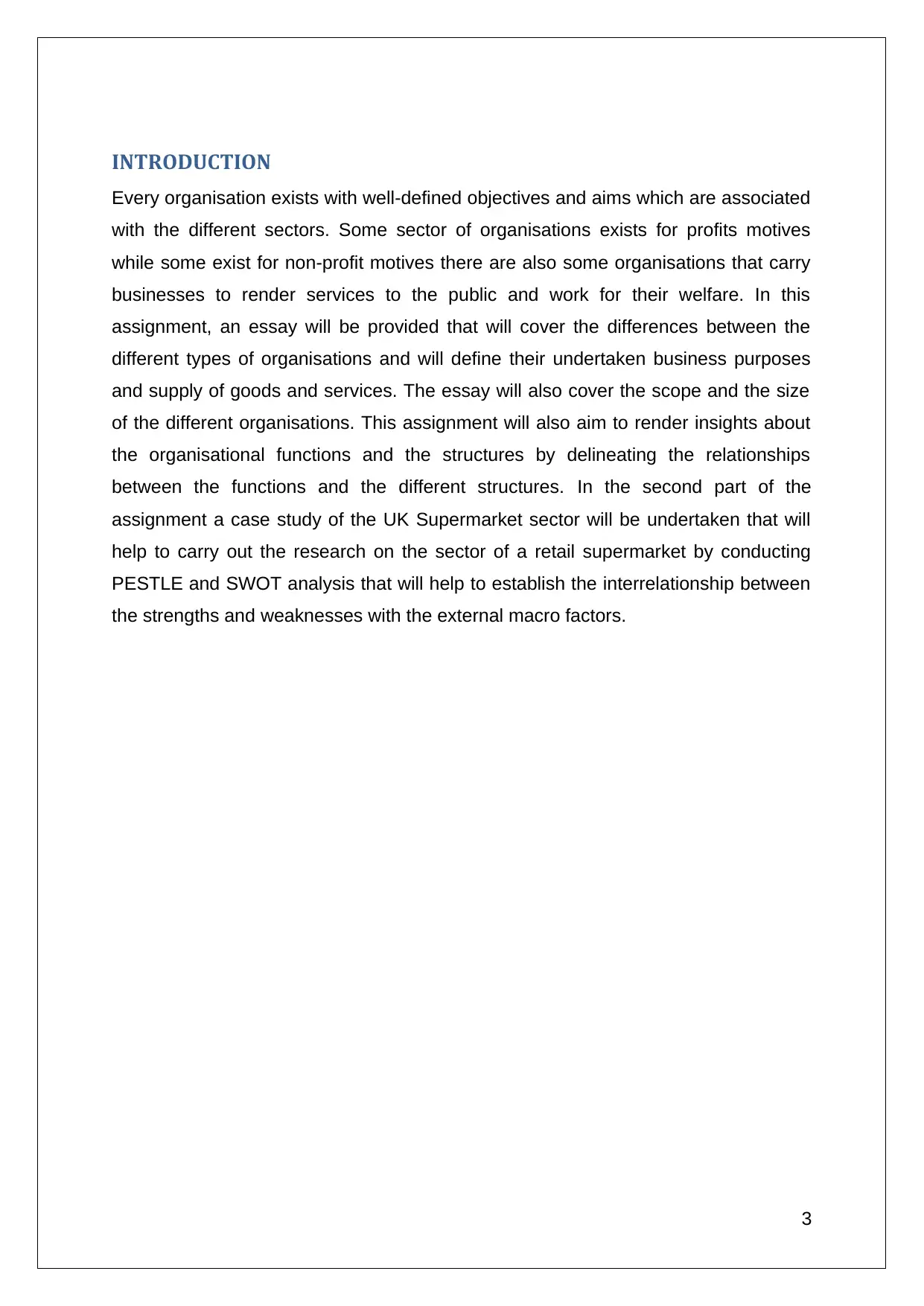
INTRODUCTION
Every organisation exists with well-defined objectives and aims which are associated
with the different sectors. Some sector of organisations exists for profits motives
while some exist for non-profit motives there are also some organisations that carry
businesses to render services to the public and work for their welfare. In this
assignment, an essay will be provided that will cover the differences between the
different types of organisations and will define their undertaken business purposes
and supply of goods and services. The essay will also cover the scope and the size
of the different organisations. This assignment will also aim to render insights about
the organisational functions and the structures by delineating the relationships
between the functions and the different structures. In the second part of the
assignment a case study of the UK Supermarket sector will be undertaken that will
help to carry out the research on the sector of a retail supermarket by conducting
PESTLE and SWOT analysis that will help to establish the interrelationship between
the strengths and weaknesses with the external macro factors.
3
Every organisation exists with well-defined objectives and aims which are associated
with the different sectors. Some sector of organisations exists for profits motives
while some exist for non-profit motives there are also some organisations that carry
businesses to render services to the public and work for their welfare. In this
assignment, an essay will be provided that will cover the differences between the
different types of organisations and will define their undertaken business purposes
and supply of goods and services. The essay will also cover the scope and the size
of the different organisations. This assignment will also aim to render insights about
the organisational functions and the structures by delineating the relationships
between the functions and the different structures. In the second part of the
assignment a case study of the UK Supermarket sector will be undertaken that will
help to carry out the research on the sector of a retail supermarket by conducting
PESTLE and SWOT analysis that will help to establish the interrelationship between
the strengths and weaknesses with the external macro factors.
3
⊘ This is a preview!⊘
Do you want full access?
Subscribe today to unlock all pages.

Trusted by 1+ million students worldwide

PART 1-ESSAY
INTRODUCTION
There are mainly three types of organisations in the business world which covers the
several aspects of the business including the profits, operations and the sales. There
is a high dependency of the business profits and the welfare. The organisations are
classified on the basis of the profitability, scope, purpose and the other factors. Thus
in the following section, the profitable, non-profitable and the non-governmental
organisations will be discussed that will also be discussed with their size, scope,
structures and the functions (Caruana and Montgomery, 2015).
BODY
LO1
P1 DIFFERENT TYPES OF ORGANISATIONS
With a common foundation on the basis of the understanding and corporation of
interests the organisations are found and they then share their interest such that the
organisation’s desired goal is achieved.
Non-Government Organisation
Aberlour Child Care Trust is a non-governmental organisation that is into helping the
young people and the families of Scotland that drives towards transforming the lives
for the betterment. It is a trust that renders support to the families by helping them
out with the disabilities, drugs and alcohol impacts and so on. The commitment is to
serve the families and the children that help in achieving the personal goals. It was
established in 1976 that aims to deliver the residential care and the dependency
services. Thus its main motive is to work for the families and the children by injecting
respect, innovation, challenges and integrity (Caruana and Montgomery, 2015).
Profit organisations
4
INTRODUCTION
There are mainly three types of organisations in the business world which covers the
several aspects of the business including the profits, operations and the sales. There
is a high dependency of the business profits and the welfare. The organisations are
classified on the basis of the profitability, scope, purpose and the other factors. Thus
in the following section, the profitable, non-profitable and the non-governmental
organisations will be discussed that will also be discussed with their size, scope,
structures and the functions (Caruana and Montgomery, 2015).
BODY
LO1
P1 DIFFERENT TYPES OF ORGANISATIONS
With a common foundation on the basis of the understanding and corporation of
interests the organisations are found and they then share their interest such that the
organisation’s desired goal is achieved.
Non-Government Organisation
Aberlour Child Care Trust is a non-governmental organisation that is into helping the
young people and the families of Scotland that drives towards transforming the lives
for the betterment. It is a trust that renders support to the families by helping them
out with the disabilities, drugs and alcohol impacts and so on. The commitment is to
serve the families and the children that help in achieving the personal goals. It was
established in 1976 that aims to deliver the residential care and the dependency
services. Thus its main motive is to work for the families and the children by injecting
respect, innovation, challenges and integrity (Caruana and Montgomery, 2015).
Profit organisations
4
Paraphrase This Document
Need a fresh take? Get an instant paraphrase of this document with our AI Paraphraser

Profits organisations are the legal entity that operates with the profit earning motives
and may in the form of the sole proprietorship, partnership and the companies.
These may involve the capital contribution by the owners and the main motive lies in
earning the profits which are transferred to the capital account (Cowling, et al. 2015).
One such example of profit organisation is Virgin Atlantic that operates in many
regions of the UK and was established in 1984 which was founded by Alan Hellary
and Randolph Fields. The main aim of this organisation comprises of rendering the
seamless travel experience that will help to render memorable experience from the
time of booking. Another aim is to render excellent value to the customers in return
for the money for the air travellers.
Not-for-profit business organisation
The non-profitable organisations are those that operate with the major aim of serving
the society (Harmon, 2015). The main motive is the service motive rather than the
profit motive. These organisations may be in the form of the trust, clubs and the
public organisations that may receive the funds from the government grants and the
donation subscriptions. One such example of the not-for-profit organisation is the
National Gallery. The National Gallery is an exempt charity organisation and a non-
departmental public body that is under the Department for Culture, Media and Sport
and it achieves its collection from the government on behalf of the British Public. It is
one of the most visited museums in the world. It was established in 1824 (Harmon,
2015).
5
and may in the form of the sole proprietorship, partnership and the companies.
These may involve the capital contribution by the owners and the main motive lies in
earning the profits which are transferred to the capital account (Cowling, et al. 2015).
One such example of profit organisation is Virgin Atlantic that operates in many
regions of the UK and was established in 1984 which was founded by Alan Hellary
and Randolph Fields. The main aim of this organisation comprises of rendering the
seamless travel experience that will help to render memorable experience from the
time of booking. Another aim is to render excellent value to the customers in return
for the money for the air travellers.
Not-for-profit business organisation
The non-profitable organisations are those that operate with the major aim of serving
the society (Harmon, 2015). The main motive is the service motive rather than the
profit motive. These organisations may be in the form of the trust, clubs and the
public organisations that may receive the funds from the government grants and the
donation subscriptions. One such example of the not-for-profit organisation is the
National Gallery. The National Gallery is an exempt charity organisation and a non-
departmental public body that is under the Department for Culture, Media and Sport
and it achieves its collection from the government on behalf of the British Public. It is
one of the most visited museums in the world. It was established in 1824 (Harmon,
2015).
5
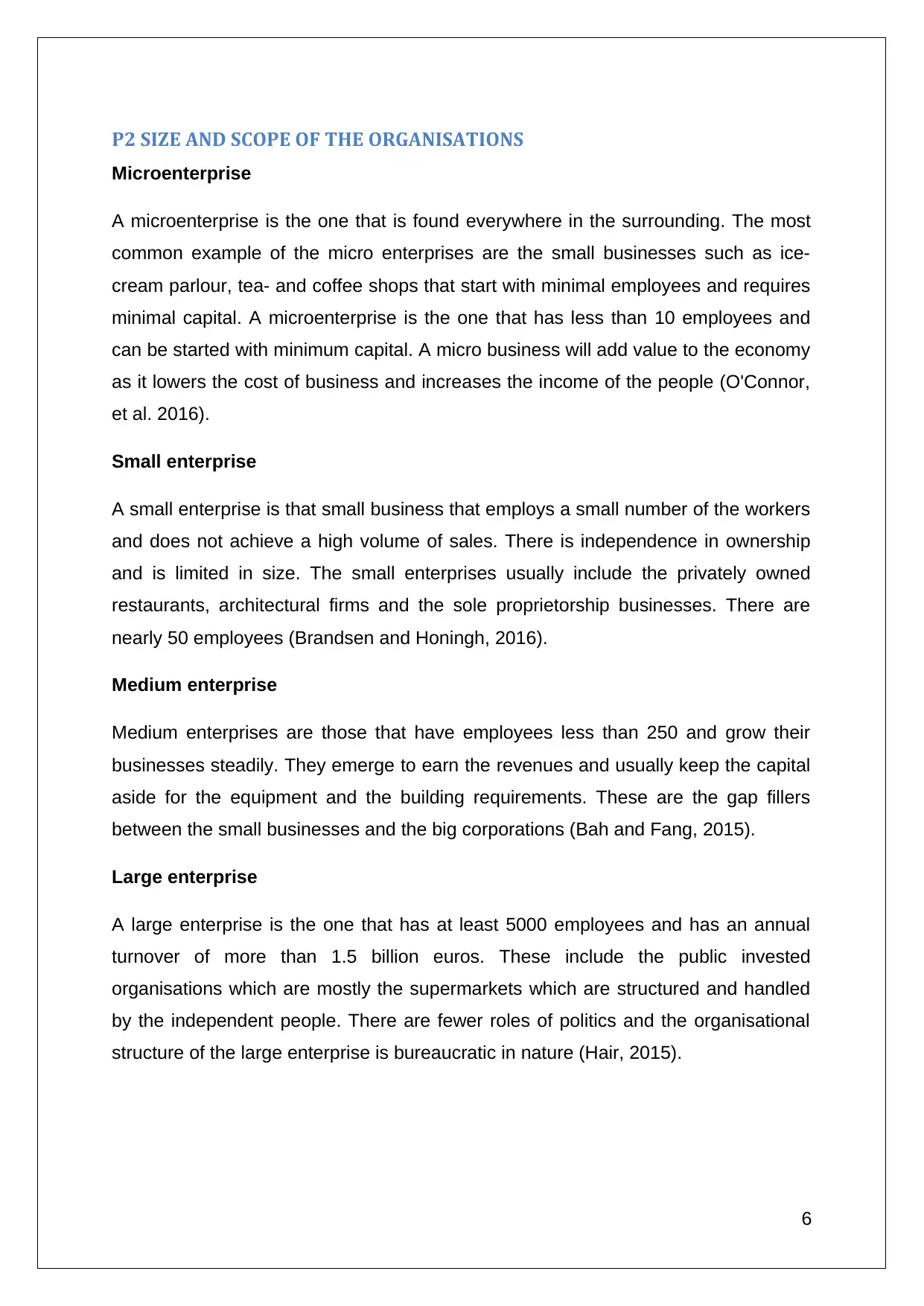
P2 SIZE AND SCOPE OF THE ORGANISATIONS
Microenterprise
A microenterprise is the one that is found everywhere in the surrounding. The most
common example of the micro enterprises are the small businesses such as ice-
cream parlour, tea- and coffee shops that start with minimal employees and requires
minimal capital. A microenterprise is the one that has less than 10 employees and
can be started with minimum capital. A micro business will add value to the economy
as it lowers the cost of business and increases the income of the people (O'Connor,
et al. 2016).
Small enterprise
A small enterprise is that small business that employs a small number of the workers
and does not achieve a high volume of sales. There is independence in ownership
and is limited in size. The small enterprises usually include the privately owned
restaurants, architectural firms and the sole proprietorship businesses. There are
nearly 50 employees (Brandsen and Honingh, 2016).
Medium enterprise
Medium enterprises are those that have employees less than 250 and grow their
businesses steadily. They emerge to earn the revenues and usually keep the capital
aside for the equipment and the building requirements. These are the gap fillers
between the small businesses and the big corporations (Bah and Fang, 2015).
Large enterprise
A large enterprise is the one that has at least 5000 employees and has an annual
turnover of more than 1.5 billion euros. These include the public invested
organisations which are mostly the supermarkets which are structured and handled
by the independent people. There are fewer roles of politics and the organisational
structure of the large enterprise is bureaucratic in nature (Hair, 2015).
6
Microenterprise
A microenterprise is the one that is found everywhere in the surrounding. The most
common example of the micro enterprises are the small businesses such as ice-
cream parlour, tea- and coffee shops that start with minimal employees and requires
minimal capital. A microenterprise is the one that has less than 10 employees and
can be started with minimum capital. A micro business will add value to the economy
as it lowers the cost of business and increases the income of the people (O'Connor,
et al. 2016).
Small enterprise
A small enterprise is that small business that employs a small number of the workers
and does not achieve a high volume of sales. There is independence in ownership
and is limited in size. The small enterprises usually include the privately owned
restaurants, architectural firms and the sole proprietorship businesses. There are
nearly 50 employees (Brandsen and Honingh, 2016).
Medium enterprise
Medium enterprises are those that have employees less than 250 and grow their
businesses steadily. They emerge to earn the revenues and usually keep the capital
aside for the equipment and the building requirements. These are the gap fillers
between the small businesses and the big corporations (Bah and Fang, 2015).
Large enterprise
A large enterprise is the one that has at least 5000 employees and has an annual
turnover of more than 1.5 billion euros. These include the public invested
organisations which are mostly the supermarkets which are structured and handled
by the independent people. There are fewer roles of politics and the organisational
structure of the large enterprise is bureaucratic in nature (Hair, 2015).
6
⊘ This is a preview!⊘
Do you want full access?
Subscribe today to unlock all pages.

Trusted by 1+ million students worldwide
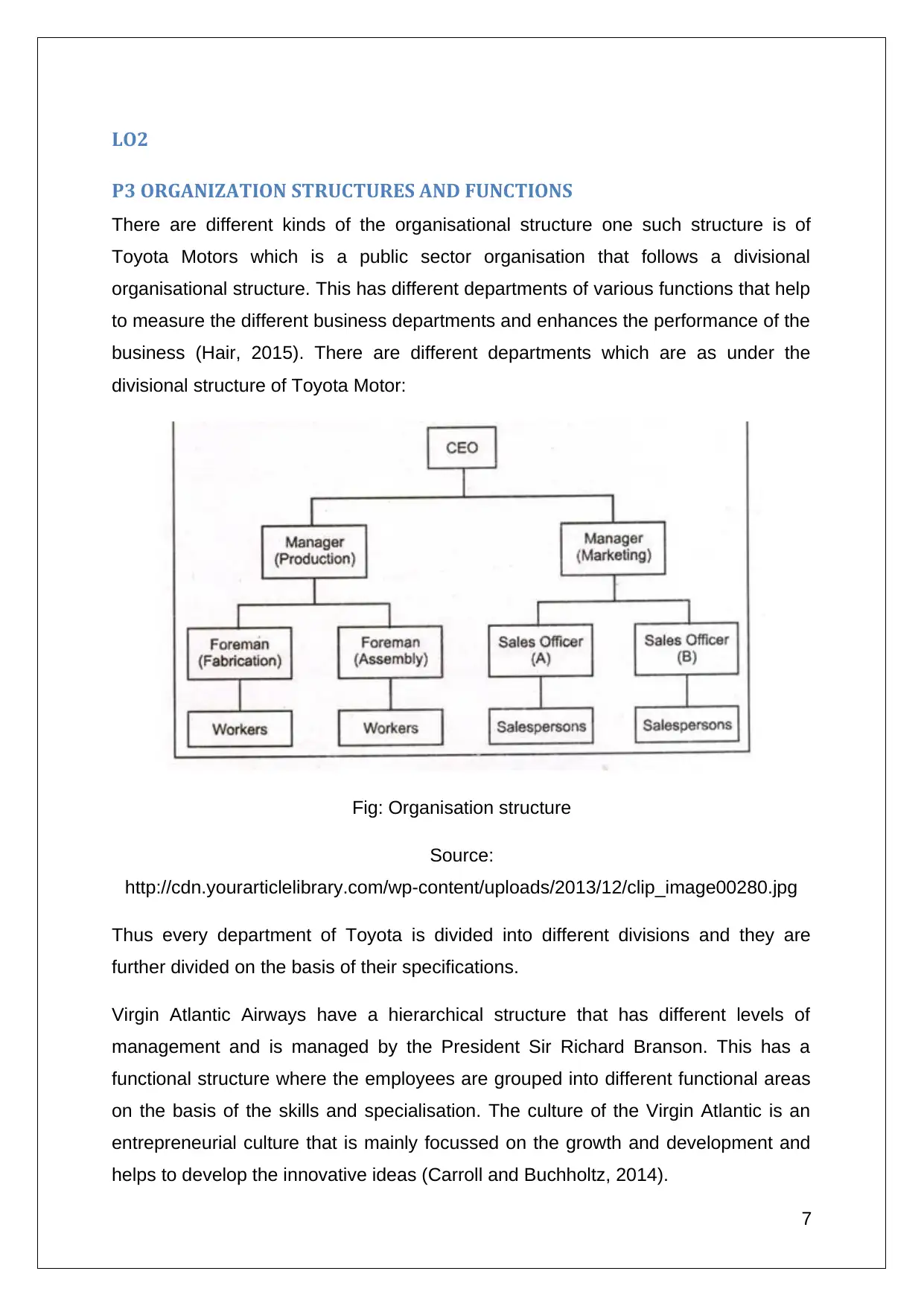
LO2
P3 ORGANIZATION STRUCTURES AND FUNCTIONS
There are different kinds of the organisational structure one such structure is of
Toyota Motors which is a public sector organisation that follows a divisional
organisational structure. This has different departments of various functions that help
to measure the different business departments and enhances the performance of the
business (Hair, 2015). There are different departments which are as under the
divisional structure of Toyota Motor:
Fig: Organisation structure
Source:
http://cdn.yourarticlelibrary.com/wp-content/uploads/2013/12/clip_image00280.jpg
Thus every department of Toyota is divided into different divisions and they are
further divided on the basis of their specifications.
Virgin Atlantic Airways have a hierarchical structure that has different levels of
management and is managed by the President Sir Richard Branson. This has a
functional structure where the employees are grouped into different functional areas
on the basis of the skills and specialisation. The culture of the Virgin Atlantic is an
entrepreneurial culture that is mainly focussed on the growth and development and
helps to develop the innovative ideas (Carroll and Buchholtz, 2014).
7
P3 ORGANIZATION STRUCTURES AND FUNCTIONS
There are different kinds of the organisational structure one such structure is of
Toyota Motors which is a public sector organisation that follows a divisional
organisational structure. This has different departments of various functions that help
to measure the different business departments and enhances the performance of the
business (Hair, 2015). There are different departments which are as under the
divisional structure of Toyota Motor:
Fig: Organisation structure
Source:
http://cdn.yourarticlelibrary.com/wp-content/uploads/2013/12/clip_image00280.jpg
Thus every department of Toyota is divided into different divisions and they are
further divided on the basis of their specifications.
Virgin Atlantic Airways have a hierarchical structure that has different levels of
management and is managed by the President Sir Richard Branson. This has a
functional structure where the employees are grouped into different functional areas
on the basis of the skills and specialisation. The culture of the Virgin Atlantic is an
entrepreneurial culture that is mainly focussed on the growth and development and
helps to develop the innovative ideas (Carroll and Buchholtz, 2014).
7
Paraphrase This Document
Need a fresh take? Get an instant paraphrase of this document with our AI Paraphraser
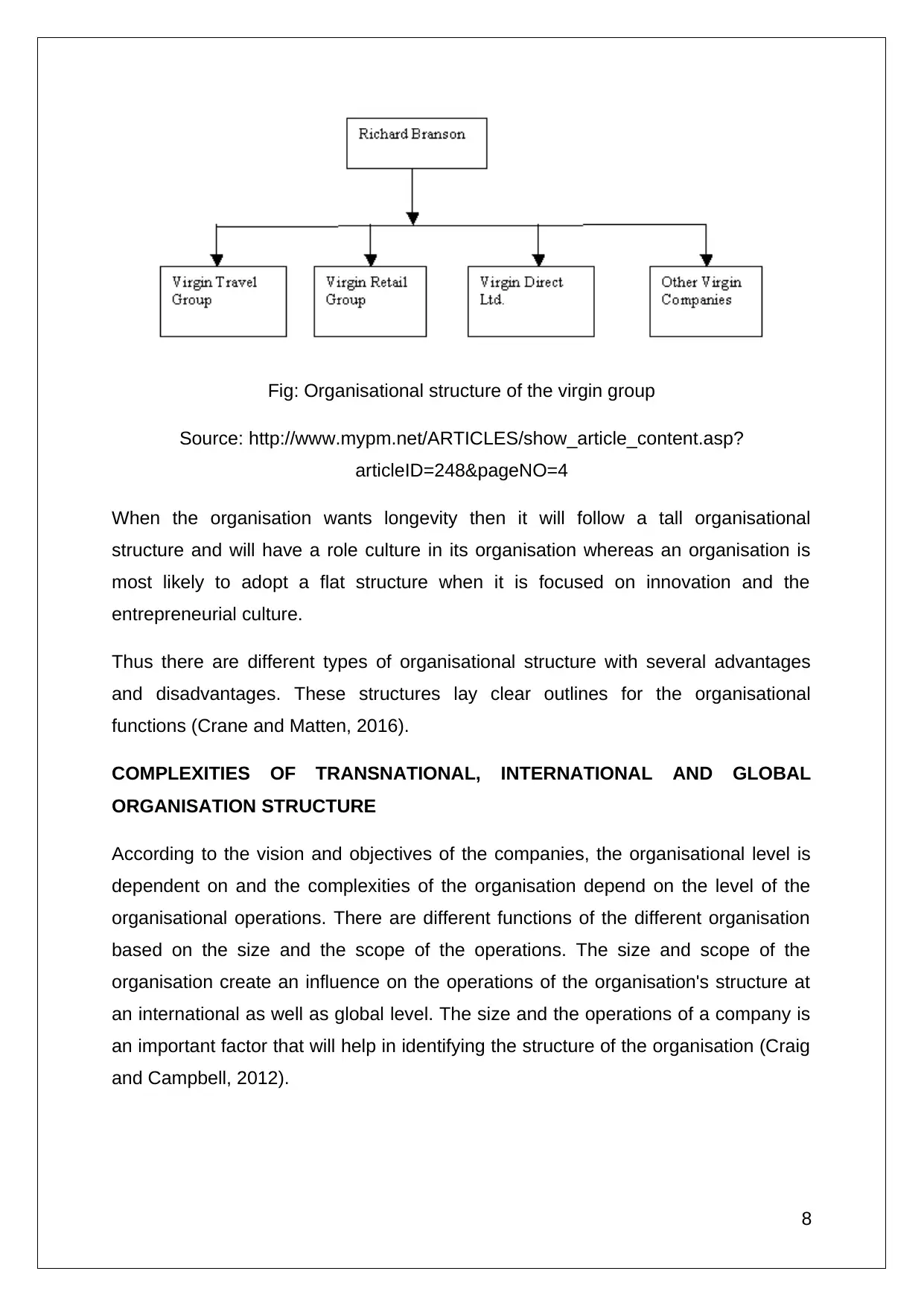
Fig: Organisational structure of the virgin group
Source: http://www.mypm.net/ARTICLES/show_article_content.asp?
articleID=248&pageNO=4
When the organisation wants longevity then it will follow a tall organisational
structure and will have a role culture in its organisation whereas an organisation is
most likely to adopt a flat structure when it is focused on innovation and the
entrepreneurial culture.
Thus there are different types of organisational structure with several advantages
and disadvantages. These structures lay clear outlines for the organisational
functions (Crane and Matten, 2016).
COMPLEXITIES OF TRANSNATIONAL, INTERNATIONAL AND GLOBAL
ORGANISATION STRUCTURE
According to the vision and objectives of the companies, the organisational level is
dependent on and the complexities of the organisation depend on the level of the
organisational operations. There are different functions of the different organisation
based on the size and the scope of the operations. The size and scope of the
organisation create an influence on the operations of the organisation's structure at
an international as well as global level. The size and the operations of a company is
an important factor that will help in identifying the structure of the organisation (Craig
and Campbell, 2012).
8
Source: http://www.mypm.net/ARTICLES/show_article_content.asp?
articleID=248&pageNO=4
When the organisation wants longevity then it will follow a tall organisational
structure and will have a role culture in its organisation whereas an organisation is
most likely to adopt a flat structure when it is focused on innovation and the
entrepreneurial culture.
Thus there are different types of organisational structure with several advantages
and disadvantages. These structures lay clear outlines for the organisational
functions (Crane and Matten, 2016).
COMPLEXITIES OF TRANSNATIONAL, INTERNATIONAL AND GLOBAL
ORGANISATION STRUCTURE
According to the vision and objectives of the companies, the organisational level is
dependent on and the complexities of the organisation depend on the level of the
organisational operations. There are different functions of the different organisation
based on the size and the scope of the operations. The size and scope of the
organisation create an influence on the operations of the organisation's structure at
an international as well as global level. The size and the operations of a company is
an important factor that will help in identifying the structure of the organisation (Craig
and Campbell, 2012).
8
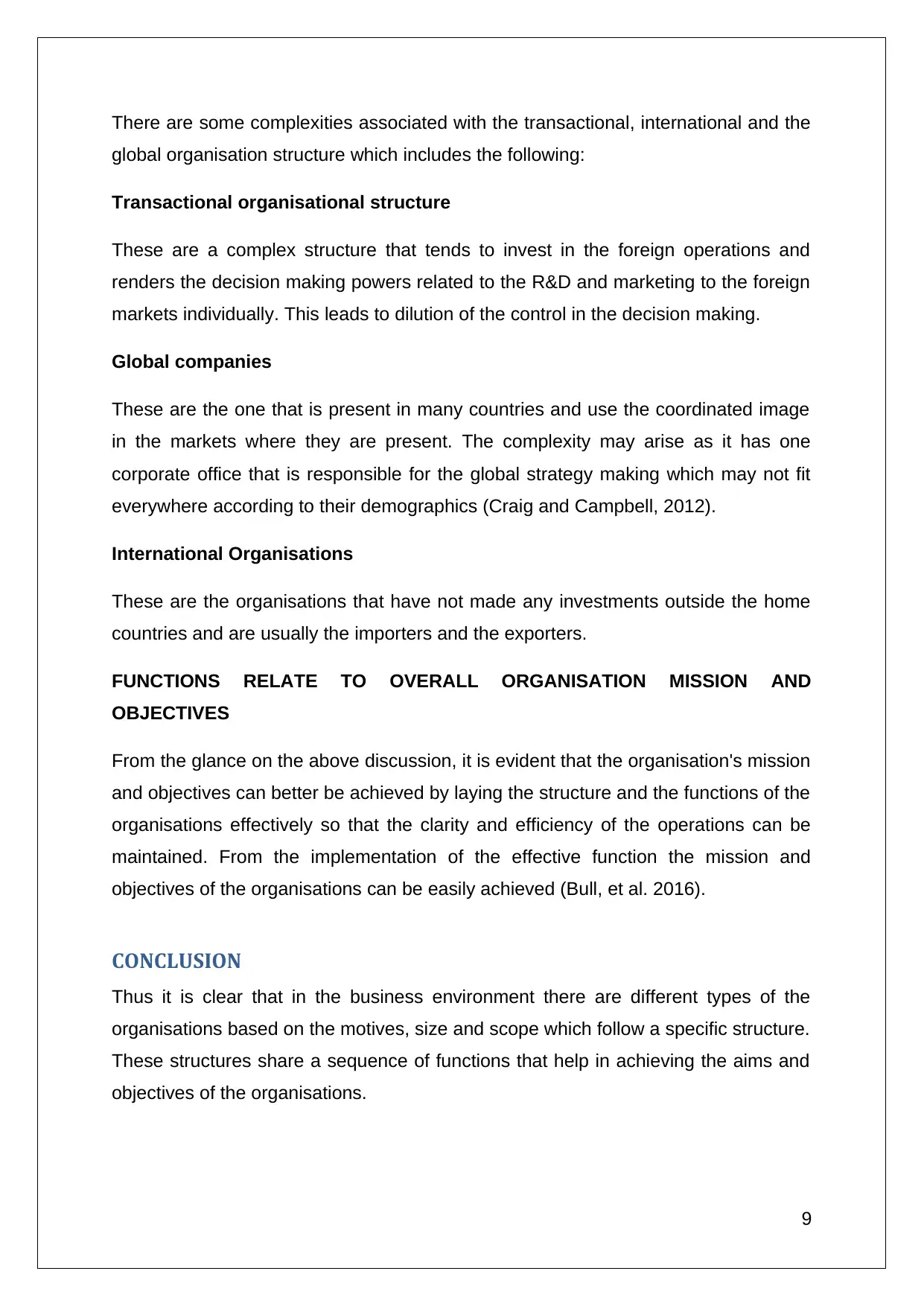
There are some complexities associated with the transactional, international and the
global organisation structure which includes the following:
Transactional organisational structure
These are a complex structure that tends to invest in the foreign operations and
renders the decision making powers related to the R&D and marketing to the foreign
markets individually. This leads to dilution of the control in the decision making.
Global companies
These are the one that is present in many countries and use the coordinated image
in the markets where they are present. The complexity may arise as it has one
corporate office that is responsible for the global strategy making which may not fit
everywhere according to their demographics (Craig and Campbell, 2012).
International Organisations
These are the organisations that have not made any investments outside the home
countries and are usually the importers and the exporters.
FUNCTIONS RELATE TO OVERALL ORGANISATION MISSION AND
OBJECTIVES
From the glance on the above discussion, it is evident that the organisation's mission
and objectives can better be achieved by laying the structure and the functions of the
organisations effectively so that the clarity and efficiency of the operations can be
maintained. From the implementation of the effective function the mission and
objectives of the organisations can be easily achieved (Bull, et al. 2016).
CONCLUSION
Thus it is clear that in the business environment there are different types of the
organisations based on the motives, size and scope which follow a specific structure.
These structures share a sequence of functions that help in achieving the aims and
objectives of the organisations.
9
global organisation structure which includes the following:
Transactional organisational structure
These are a complex structure that tends to invest in the foreign operations and
renders the decision making powers related to the R&D and marketing to the foreign
markets individually. This leads to dilution of the control in the decision making.
Global companies
These are the one that is present in many countries and use the coordinated image
in the markets where they are present. The complexity may arise as it has one
corporate office that is responsible for the global strategy making which may not fit
everywhere according to their demographics (Craig and Campbell, 2012).
International Organisations
These are the organisations that have not made any investments outside the home
countries and are usually the importers and the exporters.
FUNCTIONS RELATE TO OVERALL ORGANISATION MISSION AND
OBJECTIVES
From the glance on the above discussion, it is evident that the organisation's mission
and objectives can better be achieved by laying the structure and the functions of the
organisations effectively so that the clarity and efficiency of the operations can be
maintained. From the implementation of the effective function the mission and
objectives of the organisations can be easily achieved (Bull, et al. 2016).
CONCLUSION
Thus it is clear that in the business environment there are different types of the
organisations based on the motives, size and scope which follow a specific structure.
These structures share a sequence of functions that help in achieving the aims and
objectives of the organisations.
9
⊘ This is a preview!⊘
Do you want full access?
Subscribe today to unlock all pages.

Trusted by 1+ million students worldwide
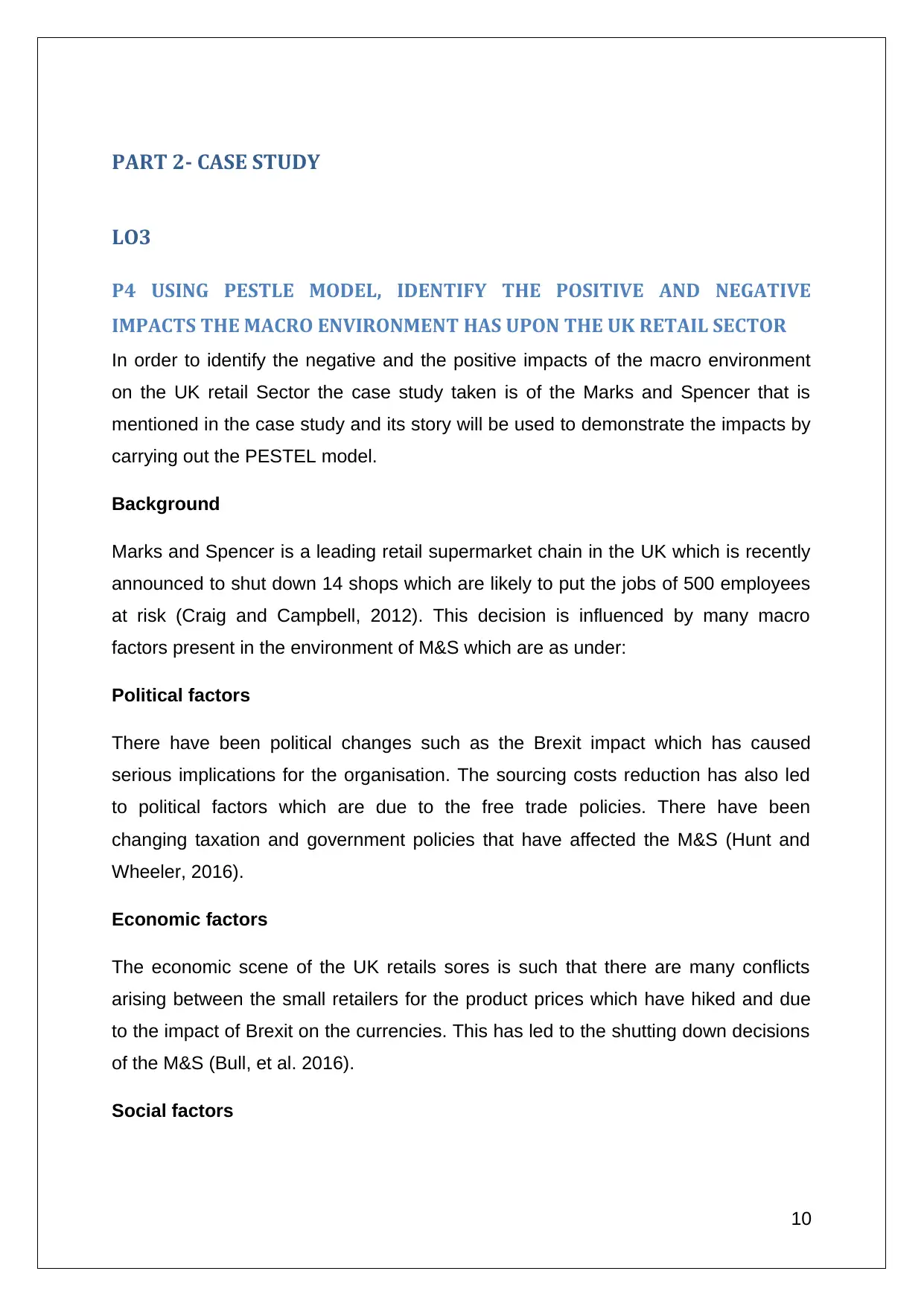
PART 2- CASE STUDY
LO3
P4 USING PESTLE MODEL, IDENTIFY THE POSITIVE AND NEGATIVE
IMPACTS THE MACRO ENVIRONMENT HAS UPON THE UK RETAIL SECTOR
In order to identify the negative and the positive impacts of the macro environment
on the UK retail Sector the case study taken is of the Marks and Spencer that is
mentioned in the case study and its story will be used to demonstrate the impacts by
carrying out the PESTEL model.
Background
Marks and Spencer is a leading retail supermarket chain in the UK which is recently
announced to shut down 14 shops which are likely to put the jobs of 500 employees
at risk (Craig and Campbell, 2012). This decision is influenced by many macro
factors present in the environment of M&S which are as under:
Political factors
There have been political changes such as the Brexit impact which has caused
serious implications for the organisation. The sourcing costs reduction has also led
to political factors which are due to the free trade policies. There have been
changing taxation and government policies that have affected the M&S (Hunt and
Wheeler, 2016).
Economic factors
The economic scene of the UK retails sores is such that there are many conflicts
arising between the small retailers for the product prices which have hiked and due
to the impact of Brexit on the currencies. This has led to the shutting down decisions
of the M&S (Bull, et al. 2016).
Social factors
10
LO3
P4 USING PESTLE MODEL, IDENTIFY THE POSITIVE AND NEGATIVE
IMPACTS THE MACRO ENVIRONMENT HAS UPON THE UK RETAIL SECTOR
In order to identify the negative and the positive impacts of the macro environment
on the UK retail Sector the case study taken is of the Marks and Spencer that is
mentioned in the case study and its story will be used to demonstrate the impacts by
carrying out the PESTEL model.
Background
Marks and Spencer is a leading retail supermarket chain in the UK which is recently
announced to shut down 14 shops which are likely to put the jobs of 500 employees
at risk (Craig and Campbell, 2012). This decision is influenced by many macro
factors present in the environment of M&S which are as under:
Political factors
There have been political changes such as the Brexit impact which has caused
serious implications for the organisation. The sourcing costs reduction has also led
to political factors which are due to the free trade policies. There have been
changing taxation and government policies that have affected the M&S (Hunt and
Wheeler, 2016).
Economic factors
The economic scene of the UK retails sores is such that there are many conflicts
arising between the small retailers for the product prices which have hiked and due
to the impact of Brexit on the currencies. This has led to the shutting down decisions
of the M&S (Bull, et al. 2016).
Social factors
10
Paraphrase This Document
Need a fresh take? Get an instant paraphrase of this document with our AI Paraphraser
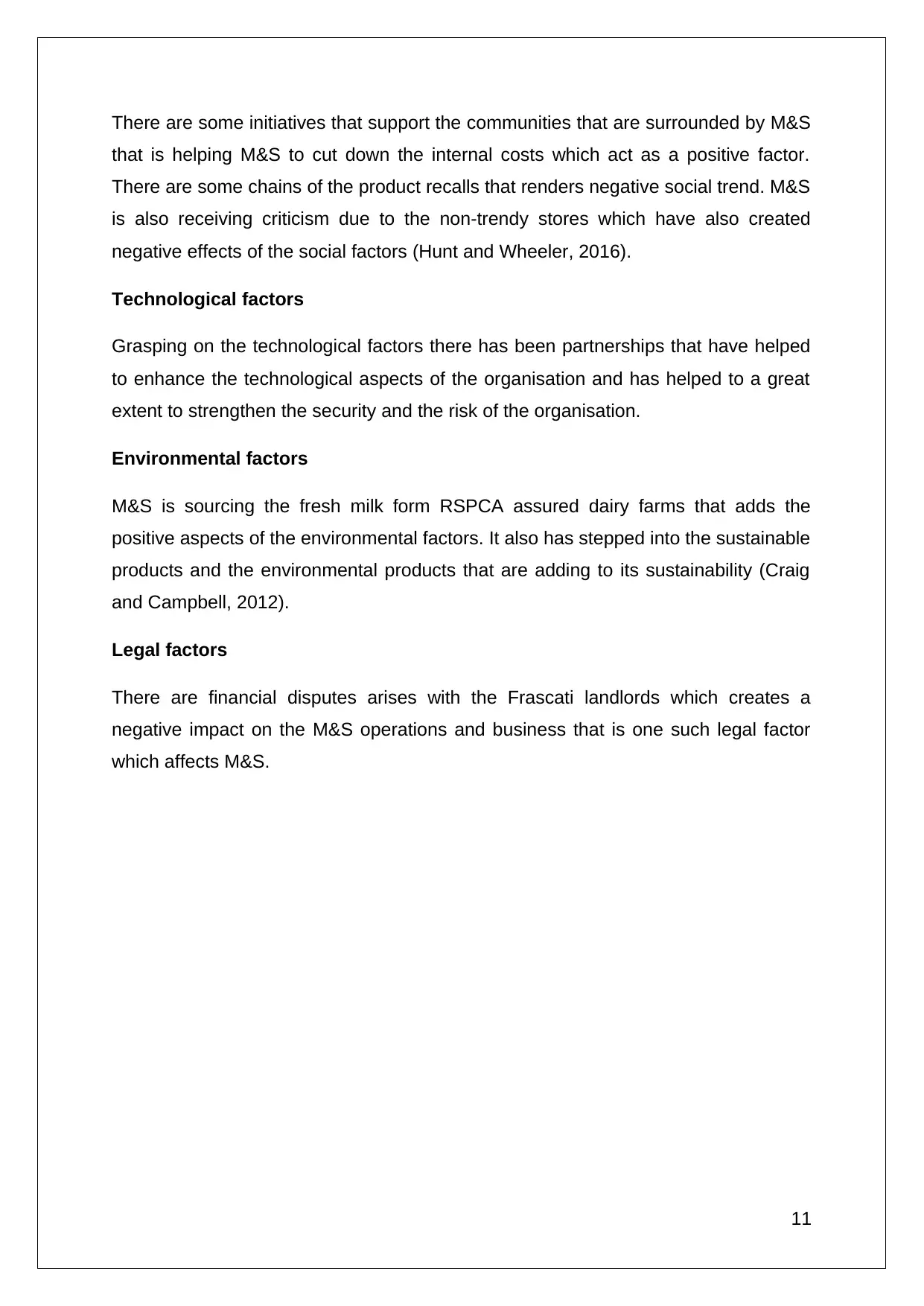
There are some initiatives that support the communities that are surrounded by M&S
that is helping M&S to cut down the internal costs which act as a positive factor.
There are some chains of the product recalls that renders negative social trend. M&S
is also receiving criticism due to the non-trendy stores which have also created
negative effects of the social factors (Hunt and Wheeler, 2016).
Technological factors
Grasping on the technological factors there has been partnerships that have helped
to enhance the technological aspects of the organisation and has helped to a great
extent to strengthen the security and the risk of the organisation.
Environmental factors
M&S is sourcing the fresh milk form RSPCA assured dairy farms that adds the
positive aspects of the environmental factors. It also has stepped into the sustainable
products and the environmental products that are adding to its sustainability (Craig
and Campbell, 2012).
Legal factors
There are financial disputes arises with the Frascati landlords which creates a
negative impact on the M&S operations and business that is one such legal factor
which affects M&S.
11
that is helping M&S to cut down the internal costs which act as a positive factor.
There are some chains of the product recalls that renders negative social trend. M&S
is also receiving criticism due to the non-trendy stores which have also created
negative effects of the social factors (Hunt and Wheeler, 2016).
Technological factors
Grasping on the technological factors there has been partnerships that have helped
to enhance the technological aspects of the organisation and has helped to a great
extent to strengthen the security and the risk of the organisation.
Environmental factors
M&S is sourcing the fresh milk form RSPCA assured dairy farms that adds the
positive aspects of the environmental factors. It also has stepped into the sustainable
products and the environmental products that are adding to its sustainability (Craig
and Campbell, 2012).
Legal factors
There are financial disputes arises with the Frascati landlords which creates a
negative impact on the M&S operations and business that is one such legal factor
which affects M&S.
11

LO4
P5 INTERNAL (SWOT/TOWS ANALYSIS) AND EXTERNAL (FIVE FORCES
MODEL) ANALYSIS OF A UK SUPERMARKET TO IDENTIFY ITS STRENGTHS
AND WEAKNESSES
SWOT ANALYSIS
A supermarket of the UK Asda will be undertaken in order to analyse the internal
factors by conducting SWOT analysis:
Strengths
Asda has the wide range of the products and the services offerings it also has
financial services with the well-known marketing campaigns. Asda keeps a frequent
touch with the customers by collecting feedbacks and through CSR initiatives on the
social networks that help to maintain the strengths of the organisations. It also has a
strong management as it has also announced recently that it will change the senior
management in the international Business Leadership in Canada, UK and China
(Hunt and Wheeler, 2016).
Weaknesses
There is a limited presence of the organisation as compared with its competitors in
the global market. The entrance of Asda is limited due to their ability to sell prices in
the dew countries as a result of the fear from the competitors with the local vendors.
Asda lacks the mini-stores which its competitors have such as Sainsbury's local and
Tesco express. There are also no loyalties cards for the customers that can keep the
customers retained in the organisation which Tesco and other stores provide to
retain their customers (Bull, et al. 2016).
Opportunities
Asda has wide opportunities available before it such as it can expand in the
opticians, pharmacies and the jewellery departments. It can also enter the new
markets like China and India through the ventures. In the UK there is the advent of
online shopping by the customers which also renders the business opportunities for
12
P5 INTERNAL (SWOT/TOWS ANALYSIS) AND EXTERNAL (FIVE FORCES
MODEL) ANALYSIS OF A UK SUPERMARKET TO IDENTIFY ITS STRENGTHS
AND WEAKNESSES
SWOT ANALYSIS
A supermarket of the UK Asda will be undertaken in order to analyse the internal
factors by conducting SWOT analysis:
Strengths
Asda has the wide range of the products and the services offerings it also has
financial services with the well-known marketing campaigns. Asda keeps a frequent
touch with the customers by collecting feedbacks and through CSR initiatives on the
social networks that help to maintain the strengths of the organisations. It also has a
strong management as it has also announced recently that it will change the senior
management in the international Business Leadership in Canada, UK and China
(Hunt and Wheeler, 2016).
Weaknesses
There is a limited presence of the organisation as compared with its competitors in
the global market. The entrance of Asda is limited due to their ability to sell prices in
the dew countries as a result of the fear from the competitors with the local vendors.
Asda lacks the mini-stores which its competitors have such as Sainsbury's local and
Tesco express. There are also no loyalties cards for the customers that can keep the
customers retained in the organisation which Tesco and other stores provide to
retain their customers (Bull, et al. 2016).
Opportunities
Asda has wide opportunities available before it such as it can expand in the
opticians, pharmacies and the jewellery departments. It can also enter the new
markets like China and India through the ventures. In the UK there is the advent of
online shopping by the customers which also renders the business opportunities for
12
⊘ This is a preview!⊘
Do you want full access?
Subscribe today to unlock all pages.

Trusted by 1+ million students worldwide
1 out of 18
Related Documents
Your All-in-One AI-Powered Toolkit for Academic Success.
+13062052269
info@desklib.com
Available 24*7 on WhatsApp / Email
![[object Object]](/_next/static/media/star-bottom.7253800d.svg)
Unlock your academic potential
Copyright © 2020–2025 A2Z Services. All Rights Reserved. Developed and managed by ZUCOL.





